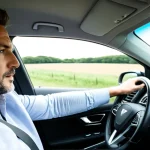Actionable Methods for Enhancing SUV Stability Control
To improve SUV handling and stability control systems, especially under challenging UK driving conditions, adopting advanced technological solutions is essential. Modern stability control systems integrate sensors that detect wheel slip and vehicle orientation, activating brake interventions to maintain control. Upgrading these systems with more sensitive sensors and faster-response controllers can significantly enhance responsiveness during abrupt maneuvers.
Practical adjustments to optimize handling include ensuring precise tyre pressure and selecting tyres designed for UK road surfaces and weather variations. Low-profile, all-season tyres improve grip, directly impacting the effectiveness of stability control systems. Additionally, fine-tuning suspension components to reduce body roll complements electronic controls by maintaining better tire contact with the road.
In the same genre : Ultimate Guide to Boosting Fuel Line Insulation for High-Performance Vehicles in the UK
Given the UK’s frequent rain and wet roads, enhancing stability control systems with traction control modules that adjust to slippery conditions is crucial. Calibration of these systems for regional road conditions can reduce oversteer and understeer during cornering. Such tailored adjustments help maximize SUV handling improvement, ensuring safer and more confident driving in diverse UK environments.
Essential Maintenance Tips for Reliable Stability Control
Maintaining stability control systems is crucial for consistent SUV safety and performance, especially given the demands of varied UK driving conditions. Regular inspection ensures sensors and electronic components remain fully operational, preventing unnoticed degradation that could compromise system reliability.
Have you seen this : Top Fabric Protection Solutions to Safeguard Your British Car Upholstery from Stains
One key area is tyre maintenance. Maintaining correct tyre pressure and tread depth directly affects traction and stability. Worn or underinflated tyres reduce grip, diminishing the effectiveness of stability control modules designed to correct skids or slips. Checking tyres regularly allows for timely replacements aligned with UK road and weather challenges.
Fault detection plays an important role in system reliability. Common issues include sensor misalignment, faulty wiring, or damaged control units. Early diagnosis through diagnostic tools or professional servicing can prevent failures before they affect SUV handling improvement. Addressing these faults promptly sustains optimal functioning of the stability control system, supporting safer driving.
In summary, combining thorough maintenance of both mechanical elements like tyres and the electronic components of stability control systems delivers the best results. This proactive strategy ensures the SUV remains responsive and safe, adapting reliably to the frequent wet or slippery surfaces encountered across the UK.
Advanced Driving Techniques for Safer SUV Performance
Mastering driving techniques tailored to UK driving conditions is essential for enhancing SUV safety and achieving enhanced stability. In wet or icy environments, adapting speed and steering input reduces the risk of losing control. For example, gradual acceleration and smooth braking help maintain traction, supporting the stability control systems in managing wheel slip effectively.
How can drivers best utilize electronic stability programs and traction controls? These systems work optimally when the driver allows them to intervene early by driving predictably—avoiding sudden jerks or harsh maneuvers. The electronic aids detect discrepancies in wheel speed and vehicle orientation, then adjust power or brake force, preventing skids. Understanding this interplay encourages drivers to trust, rather than override, these safety features.
Defensive driving further boosts SUV handling improvement by anticipating hazards before they arise. Maintaining safe following distances and scanning for slippery patches allow the vehicle’s stability control systems to react in a timely manner. Such techniques are particularly vital given the UK’s frequently changing weather, where road grip can deteriorate unexpectedly.
Overall, combining informed driving techniques with active use of vehicle safety technologies creates a safer driving experience. This synergy maximizes both human and automated efforts to preserve SUV safety across varied UK driving conditions.
Recommended Upgrades and Expert Product Insights
Enhancing stability control technology in SUVs can dramatically improve SUV handling improvement, especially under diverse UK driving conditions. Notable aftermarket products include advanced Electronic Stability Programs (ESP) and traction control modules designed for quicker response and adaptability to slippery roads. Integrating these upgraded systems requires precise calibration to the vehicle’s dynamics, ensuring seamless operation with existing components.
Expert automotive advice emphasizes selecting reputable suppliers that specialize in stability control upgrades tailored to SUVs. These experts recommend products featuring adaptive algorithms that adjust braking and torque distribution based on real-time sensor data. Such technology improves vehicle balance and reduces oversteer or understeer scenarios, crucial for the UK’s frequently wet and unpredictable roads.
When considering SUV upgrades, compatibility and installation quality are paramount. Professional installation guarantees that upgraded modules effectively communicate with factory systems, maintaining overall stability control system reliability and SUV safety standards. Additionally, some upgrades offer customizable settings, letting drivers optimize handling performance further for specific UK driving conditions.
In summary, investing in expert-recommended stability control enhancements delivers tangible benefits in safety and handling. These upgrades provide drivers with more confident control, supporting improved performance in challenging environments.
Navigating UK Regulations and Safety Standards
Understanding UK vehicle regulations is vital for ensuring SUV compliance with mandatory safety features, particularly stability control systems. Since 2014, the UK law mandates Electronic Stability Control (ESC) in all new SUVs, aiming to reduce accidents related to loss of vehicle control. This legal requirement underscores the importance of advanced stability control technology in enhancing SUV safety across the varied UK driving conditions.
What are the best practices for ensuring compliance? Regular system checks during vehicle inspections confirm that stability control systems operate within approved standards. Failure to comply can affect insurance coverages, making it crucial for drivers to maintain their SUV’s stability aids properly. Insurance providers often consider compliance status when assessing risk profiles and premiums.
Legislation incentivizes technological adoption by setting thresholds for safety performance. This prompts manufacturers and drivers to prioritize SUV handling improvement through reliable stability control functions. Drivers must also remain responsible by understanding how these systems work and adapting their driving accordingly.
In summary, the integration of UK vehicle regulations with evolving safety standards drives continuous improvement in SUV stability control technologies. Ensuring compliance not only meets legal requirements but also advances overall vehicle safety in challenging UK environments.


